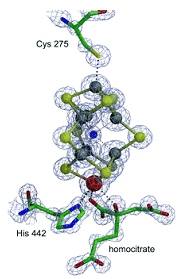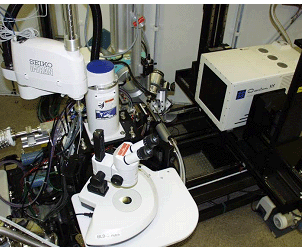 The Research group of Douglas Rees at the California Institute of Technology collected X-ray crystallographic data to a resolution of 1.16 Å at SSRL Beam Line 9-2 using the new Quantum-315 CCD detector from crystals of Nitrogenase MoFe-Protein, an extremely efficient enzyme found in bacteria that catalyzes the production of ammonia from dinitrogen. Bacteria produce about half of the world’s bio-nitrogen available for agriculture, the rest comes from nitrogenous fertilizer produced chemically at extreme temperature and pressure, consuming about 1% of the world's total annual energy supply. The refined ultra-high resolution structure has recently been published in Science 2002, 297, 1696-1700.
The Research group of Douglas Rees at the California Institute of Technology collected X-ray crystallographic data to a resolution of 1.16 Å at SSRL Beam Line 9-2 using the new Quantum-315 CCD detector from crystals of Nitrogenase MoFe-Protein, an extremely efficient enzyme found in bacteria that catalyzes the production of ammonia from dinitrogen. Bacteria produce about half of the world’s bio-nitrogen available for agriculture, the rest comes from nitrogenous fertilizer produced chemically at extreme temperature and pressure, consuming about 1% of the world's total annual energy supply. The refined ultra-high resolution structure has recently been published in Science 2002, 297, 1696-1700.
The high resolution analysis (Einsle et al. 2002) revealed a previously unrecognizable ligand coordinated to six iron atoms in the FeMo-cofactor catalytic site of nitrogenase. The electron density for this ligand which is masked in structures with resolutions lower than 1.5 Å, is consistent with being a light element, most likely nitrogen. The presence of a nitrogen atom in the cofactor would have important implications for the mechanism of dinitrogen reduction which may in turn help chemists to desig n a more efficient method for producing ammonia from atmospheric nitrogen.
 Representation of the catalytic FeMo-cofactor with the newly identified ligand modeled as a nitrogen atom (blue sphere). Molybdenum is shown in red, sulfur, yellow and iron, green. The electron density show n is from a 2Fo – Fc map of the 1.16 Å resolution structure of dithionite-reduced A. vinelandii MoFe-protein contoured at 3σ.
Representation of the catalytic FeMo-cofactor with the newly identified ligand modeled as a nitrogen atom (blue sphere). Molybdenum is shown in red, sulfur, yellow and iron, green. The electron density show n is from a 2Fo – Fc map of the 1.16 Å resolution structure of dithionite-reduced A. vinelandii MoFe-protein contoured at 3σ.
This work was made possible with the availability of a large-area Quant um-315 CCD detector funded by the NIH-NIGMS, installed on the high-intensity wiggler endstation, BL9-2 using an advanced data collection environment developed at the SSRL structural biology resource. The detector has a large active area of 315 mm x 315 mm and a rapid readout speed of ~1 second in full resolution mode (51 x 51 m2 pixels) – ideal for collecting ultra-high resolution data in a single data collection pass. Nitrogenase data were collected at a waveleng th of 0.998 Å; the ultra-high resolution data set used 0.2° rotations with a relatively long exposure of 60 s per image and a quick low resolution pass used 0.5° rotations with short 10 s exposures. In all, 2 x 180° of data (1260 images total) were collected in less than 17 hrs with no added time for detector readout or for additional data sets with the detector in an offset position.Beam Line 9-2 is currently being outfitted with a standard 284-sample changing system originally developed at BL11-1, which will automate and optimize the screening process for identifying the highest quality crystals for ultra-high resolution data collection experiments. The overall system will be optimized for performing the highest quality experiments in the shortest time possible, maximizing both experimental throughput and scientific results.
- O. Einsle, O., Tezcan, F. A., Andrade, S. L. A., Schmid, B., Yoshida, M., Howard, J. B., Rees, D. C. (2002) Nitrogenase MoFe-Protein at 1.16 Å Resolution: A Central Ligand in the FeMo-Cofactor, Science 297 1696-1700.
See also:
Barry E. Smith's perspective in STRUCTURE: Nitrogenase Reveals Its Inner SecretsScience 297 1654-1655.




